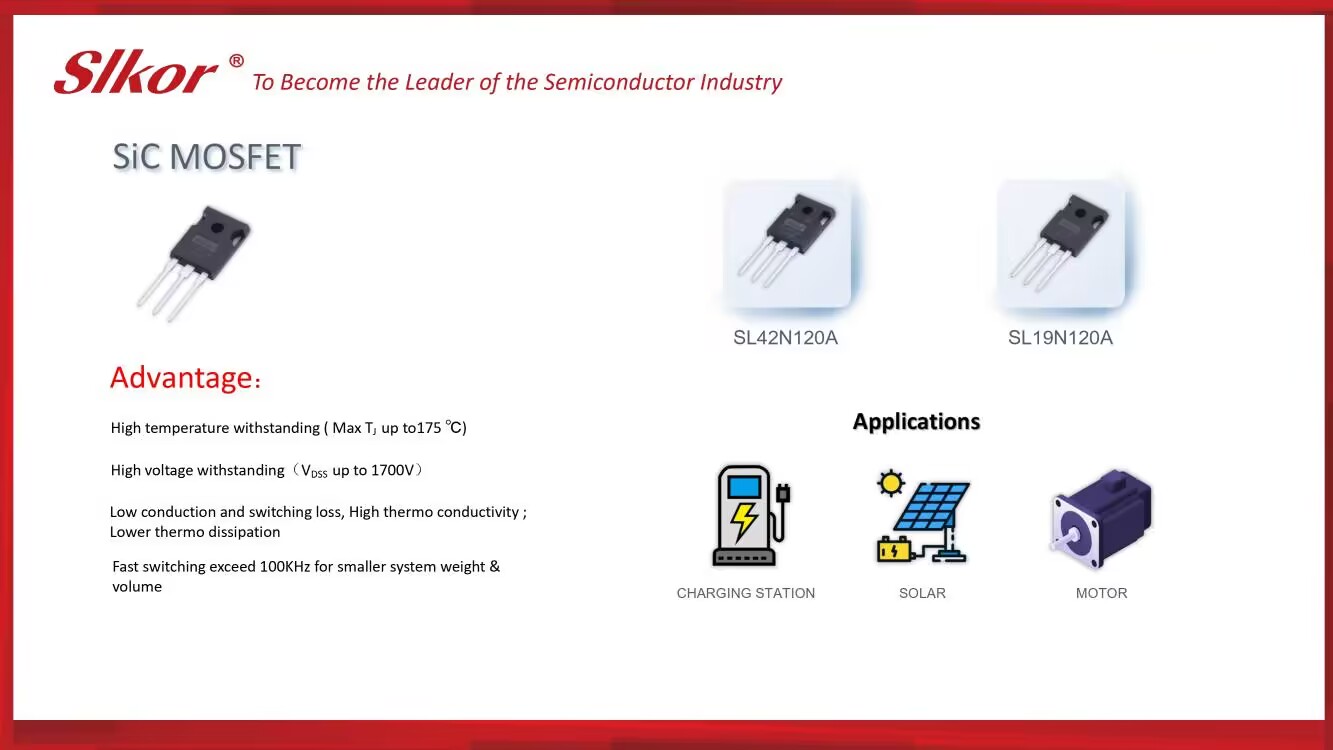Service hotline
+86 0755-83044319
release time:2024-07-29Author source:SlkorBrowse:14190
With rapid advancements in electronic technology, semiconductor devices play a crucial role in the functionality and efficiency of modern electronic products. Silicon Carbide (SiC) has emerged as a key focus of research and application due to its excellent physical and thermal properties. Among its various applications, SiC Field-Effect Transistors (SiC FETs) stand out due to their unique advantages and characteristics.
l Excellent High-Temperature Performance: SiC material exhibits superior thermal conductivity and stability, enabling SiC FETs to operate reliably in high-temperature environments, meeting the demands of high-temperature electronic devices.
l High-Frequency Capability: With high electron saturation drift velocity and electron mobility, SiC FETs deliver better response speed and signal transmission characteristics in high-frequency circuits.
l Low Switching Losses: SiC material's low on-state resistance and fast switching speeds reduce energy losses significantly, enhancing overall energy conversion efficiency in power switch applications.
l High Radiation Tolerance: SiC material has a higher threshold for electron beam radiation damage, providing SiC FETs with longer lifespans and greater reliability in environments with high radiation levels, such as space and nuclear power applications.
l Drain-Source Voltage (V_DS): Typically ranges from hundreds to thousands of volts, depending on the voltage requirements of the application.
l Drain-Source Current (I_D): Maximum current that the SiC FET can handle in conduction mode, determining its power handling capability.
l Gate-Source Voltage (V_GS): Controls the conduction and cutoff states of the SiC FET, directly influencing its switching characteristics and operational stability.
l On-State Resistance (R_DS(on)): Describes the resistance of the SiC FET when conducting, directly impacting power loss and thermal characteristics.
l Switching Speed: Reflects the response speed of the SiC FET during switching, typically measured by rise and fall times.
Differences Between SiC MOSFETs and Conventional MOSFETs
While structurally similar to traditional silicon-based FETs, SiC FETs exhibit significant differences in performance and application:
l Material Properties: SiC material offers higher thermal conductivity and electron mobility compared to silicon, making SiC FETs more suitable for high-temperature and high-power applications.
l Performance Optimization: SiC FETs excel in power losses, switching speed, and radiation resistance, making them ideal for demanding electronic environments.
l Application Areas: SiC FETs find extensive use in power electronics, electric vehicle chargers, wind power generation, solar inverters, and other high-efficiency electronic devices, whereas traditional silicon FETs are more common in low-power electronic devices and general circuit control.
Conclusion
As an innovative semiconductor technology, SiC FETs are poised to drive further advancements in electronic technology. Continued advancements in manufacturing processes and application technologies are expected to expand the scope of SiC FETs, replacing traditional silicon materials in more electronic product designs and manufacturing processes. This evolution promises to foster sustainable and efficient development opportunities for the global electronics industry.










Site Map | 萨科微 | 金航标 | Slkor | Kinghelm
RU | FR | DE | IT | ES | PT | JA | KO | AR | TR | TH | MS | VI | MG | FA | ZH-TW | HR | BG | SD| GD | SN | SM | PS | LB | KY | KU | HAW | CO | AM | UZ | TG | SU | ST | ML | KK | NY | ZU | YO | TE | TA | SO| PA| NE | MN | MI | LA | LO | KM | KN
| JW | IG | HMN | HA | EO | CEB | BS | BN | UR | HT | KA | EU | AZ | HY | YI |MK | IS | BE | CY | GA | SW | SV | AF | FA | TR | TH | MT | HU | GL | ET | NL | DA | CS | FI | EL | HI | NO | PL | RO | CA | TL | IW | LV | ID | LT | SR | SQ | SL | UK
Copyright ©2015-2025 Shenzhen Slkor Micro Semicon Co., Ltd